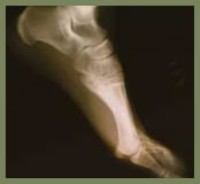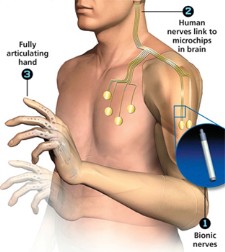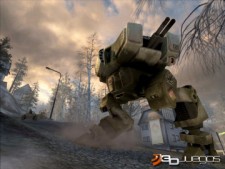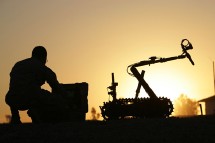New Bionics For the New Robotic Army
| General Douglas MacArthur once said "Old soldiers never die; they just fade away." not so anymore ... Today, it is the devastating injuries suffered by soldiers returning from Iraq and Afghanistan that are driving research for new and better limbs. Most military patients say they want to return to active service using prostheses. If they are going to jump out of airplanes, they need a limb that can withstand such forces, said Brian Hafner, research director for Prosthetics Research Study. *Seattle researchers at the forefront for amputees Rehabilitation Institute of Chicago Unveils World's First "Bionic Woman" Claudia Mitchell, the first woman to be successfully fit with RIC's original Bionic Arm technology. The most advanced prosthesis of its kind, the RIC neuro-controlled Bionic Arm allows an amputee to move his or her prosthetic arm as if it is a real limb simply by thinking.  *World’s First Bionic Woman  Today, amputees have a wide array of feet to choose from, designed for walking, dancing, cycling, golfing, swimming, snow skiing and running. Heavier wood and steel materials have been replaced by lightweight plastics, aerospace alloys and carbon-fiber composites. Today, amputees have a wide array of feet to choose from, designed for walking, dancing, cycling, golfing, swimming, snow skiing and running. Heavier wood and steel materials have been replaced by lightweight plastics, aerospace alloys and carbon-fiber composites.Much like the human foot , many of today’s prosthetic feet can store and return some of the energy generated during walking. Other key attributes include toe and heel springs that allow more natural movement at the ankle, shock absorption, multiaxial rotation, adjustable heel heights and waterproof materials. *Prosthetic Feet New prosthetic feet are so advanced, they may even allow amputee soldiers back into battle. *Bionic Man  Advances in prosthetics include the development of new, tough, but lightweight materials, better shapes and designs, and most recently the increased use of computers embedded within artificial limbs. They allow prostheses to more closely mimic the movements and agility of real limbs.  Science Fiction Becomes Reality  The Defense Advanced Research Projects Agency, or DARPA is the central research and development organization for the Department of Defense (DoD). It manages and directs selected basic and applied research and development projects for DoD. It pursues research and technology where risk and payoff are both very high and where success may provide dramatic advances for traditional military roles and missions. See *DARPA 2006 News Releases Also see *Fighting Military Robots Military Medical Technology Links *Revolutionizing Prosthetics *New Center Offers Renewed Hope for Military Amputees *New High-tech Prostheses Being Developed for Amputees  Pentagon Plans to Draft Robot Army The military plans to invest tens of billions of dollars in automated armed forces; a program designed to build heavily-armed robots for the battlefield. The Pentagon is spending $161 billion on *Future Combat Systems, which is the largest military contract in American history and will help to drive the defence budget up by almost 20 per cent in five years' time. The costs of that transformation will help drive the Defense Department's budget up from a requested $419.3 billion for next year to $502.3 billion in 2010, excluding the costs of war. The annual costs of buying new weapons is scheduled to rise 52 percent, from $78 billion to $118.6 billion. "They don't get hungry," said Gordon Johnson of the Joint Forces Command at the Pentagon. "They're not afraid. They don't forget their orders. They don't care if the guy next to them has just been shot. Will they do a better job than humans? Yes." Robots in battle, as envisioned by their builders, may look and move like humans or hummingbirds, tractors or tanks, cockroaches or crickets. With the development of nano technology they may become swarms of "smart dust." The Pentagon intends for robots to haul munitions, gather intelligence, search buildings or blow them up. "The lawyers tell me there are no prohibitions against robots making life-or-death decisions," said Mr. Johnson, who leads robotics efforts at the Joint Forces Command research center in Suffolk, Va. The Pentagon predicts that robots will be a major fighting force in the American military in less than a decade. Hunting for guerillas, handling roadside bombs, crawling across the caves and crumbling towns of Afghanistan and Iraq; all of that was just a start. Now, the Army is prepping its squad of robotic vehicles for a new set of assignments. And this time, they'll be carrying guns ... "This opens up great vistas, some quite pleasant, others quite nightmarish.On the one hand, this could make our flesh-and-blood soldiers so hard to get to that traditional war -- a match of relatively evenly matched peers -- could become a thing of the past," he said. "But this might also rob us of our humanity. We could be the ones that wind up looking like Terminators, in the world's eyes." If battle bots ever do take on the bulk of frontline fighting, the results could transform military strategy. none repeat *Battle bot: the future of war? A Future Horizons' report contends that "the electronics industry is on the cusp of a robotics wave, a period in which applications are aimed at human labour saving and extending human skills. It states that the market need, technology and economical justification have coincided to create a new electro mechanical robot system." And here is the key prediction: "By 2010 the $59.3bn worldwide robotic market will equate to 55.5 million units made up of domestic robots accounting for 39 million units; domestic intelligent service robots accounting for 10.5 million units; professional intelligent service robots accounting for 5.8 million units; and accounting for heavy industrial robots." ... Settle on your jet pack, hitch up your blaster, and tune in the videotron as we tour Future Past! Have you ever met a real robot? You might have if you work in a factory, nuclear power plant or military facility where people are not allowed to go. Nevertheless, robots are turning up in new places every day. Chances are good thatyou will meet one of them sometime soon ... The US military's current armoury of unmanned spyplanes and weapons is to be vastly expanded through the addition of armies of robot soldiers, replacing and/or supplementing the real grunts, In future wars, robots may drop from the sky by the hundreds from unmanned aircraft, swarming like giant insects over battlefields in coordinated, terrifying assaults. Future wars could be fought by robots commanded by humans. We could withdraw from war completely and let robots shoot it out. The SWORDS, short for Special Weapons Observation Reconnaissance Detection Systems, will be the first armed robotic vehicles to see combat, years ahead of the larger Future Combat System vehicles currently under development by big defense contractors such as Lockheed Read more ... There are more than 100 Talon Robots at work in Iraq and Afghanistan ... *Talon Military Robot One measure of how effective battlefield robots have become, says a top Pentagon robotics official, is that the enemy has begun to target them ... *Battlefield robots saving lives The U.S. military has been developing robotic systems for all sorts of jobs for years now. References ... *How Military Robots Work *Military Robots the Next Step *Robot Soldiers *Looking to Iraq, Military Robots *Rugged Robots Help Troops Technocrati Tags Prosthetics Research, Military Robots, Rehabilitation Institute of Chicago, Bionic Woman, Prosthetic Feet, Bionic Man Future Combat Systems, Defense Department , Joint Forces Command, Battle Bots, Robotic Market, Special Weapons Observation Reconnaissance Detection Systems Labels: Armageddon, Bible Prophecy, Bush Brotherhood of Death  Stumble It! Stumble It! |

























































Comments on "New Bionics For the New Robotic Army"
post a comment